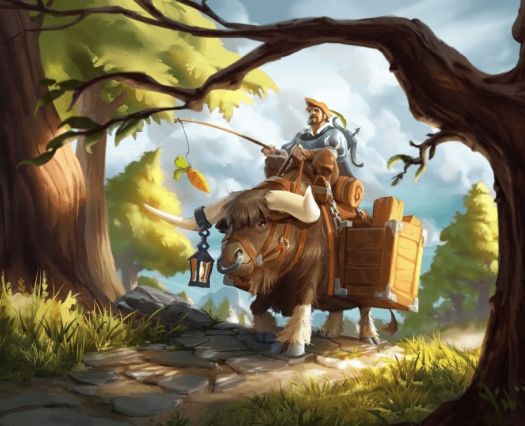Difference between revisions of "Ox Tether"
Tao alexis (talk | contribs) |
Tao alexis (talk | contribs) |
||
| (8 intermediate revisions by the same user not shown) | |||
| Line 1: | Line 1: | ||
| − | [[File:Ox Tether.jpg|right|525px|thumb]] | + | [[File:Ox Tether (facility).jpg|right|525px|thumb]] |
| − | '''Ox tethers''' are enclosed or open air ox stalls, where cows are tethered and restricted to sitting or standing while being loaded with goods. Places that are difficult to reach due to lack of roads, that depend upon [[Roads & Routes|paths]] for access, commonly depend on oxen and baskets for transport. This is especially true of mining hamlets and thorps, which ship stone or metal ores. | + | '''Ox tethers''' are enclosed or open air [[Oxen|ox]] stalls, where cows are tethered and restricted to sitting or standing while being loaded with goods. Places that are difficult to reach due to lack of roads, that depend upon [[Roads & Routes|paths]] for access, commonly depend on oxen and baskets for transport. This is especially true of mining [[Hamlet|hamlets]] and [[Thorp|thorps]], which ship stone or metal ores. |
While being loaded, an ox is held in place by a chain or strap under its neck, restricting movement and forcing the animal to remain standing. When not being loaded, cows are untethered and allowed into a yard, often an area that's naturally enclosed by stone outcroppings or riverbanks. If needed, stiles are erected and troughs as well, to ensure the animals are well-fed for heavy work. | While being loaded, an ox is held in place by a chain or strap under its neck, restricting movement and forcing the animal to remain standing. When not being loaded, cows are untethered and allowed into a yard, often an area that's naturally enclosed by stone outcroppings or riverbanks. If needed, stiles are erected and troughs as well, to ensure the animals are well-fed for heavy work. | ||
| − | == | + | The population supported by an ox tether equals a 60/40 chance of 1 or 2-3. |
| − | The tether is constructed of two heavy blocks with | + | |
| + | == Construction == | ||
| + | The tether is constructed of two heavy blocks made of stone, with an iron pole between them, normally sufficient for 8 to 10 animals. The animal's induced to put it's head over the bar, whereupon it's tethered in place. [[Oxgoading (sage ability)|Oxgoading]] skill is necessary for safely tethering an ox to make it ready for loading. The goader is most likely a loner, dwelling nearby with either a spouse or grown offspring. | ||
| + | |||
| + | == Usefulness == | ||
| + | The presence of ox tethers wanes with the proliferation of roads, though some [[Village|villages]] and country [[Town|towns]] continue to rely upon them as incoming farmers and prospectors bring in their wares. In such cases, the tether is used more for storage than for loading, though some goods may be carried into rural or hinterland parts. Carts and wagons are better than oxen for transport, however, so that the latter may be so uncommon that a simple block with an iron ring is enough to supplant a lengthy tether. | ||
| + | |||
| + | |||
| + | See also,<br> | ||
| + | [[Hammer (symbol)]]<br> | ||
| + | [[The Adventure]]<br> | ||
| + | [[Type-7 Hex]] | ||
| + | |||
| + | [[Category: Facilities]] | ||
Latest revision as of 20:13, 6 December 2022
Ox tethers are enclosed or open air ox stalls, where cows are tethered and restricted to sitting or standing while being loaded with goods. Places that are difficult to reach due to lack of roads, that depend upon paths for access, commonly depend on oxen and baskets for transport. This is especially true of mining hamlets and thorps, which ship stone or metal ores.
While being loaded, an ox is held in place by a chain or strap under its neck, restricting movement and forcing the animal to remain standing. When not being loaded, cows are untethered and allowed into a yard, often an area that's naturally enclosed by stone outcroppings or riverbanks. If needed, stiles are erected and troughs as well, to ensure the animals are well-fed for heavy work.
The population supported by an ox tether equals a 60/40 chance of 1 or 2-3.
Construction
The tether is constructed of two heavy blocks made of stone, with an iron pole between them, normally sufficient for 8 to 10 animals. The animal's induced to put it's head over the bar, whereupon it's tethered in place. Oxgoading skill is necessary for safely tethering an ox to make it ready for loading. The goader is most likely a loner, dwelling nearby with either a spouse or grown offspring.
Usefulness
The presence of ox tethers wanes with the proliferation of roads, though some villages and country towns continue to rely upon them as incoming farmers and prospectors bring in their wares. In such cases, the tether is used more for storage than for loading, though some goods may be carried into rural or hinterland parts. Carts and wagons are better than oxen for transport, however, so that the latter may be so uncommon that a simple block with an iron ring is enough to supplant a lengthy tether.
See also,
Hammer (symbol)
The Adventure
Type-7 Hex
